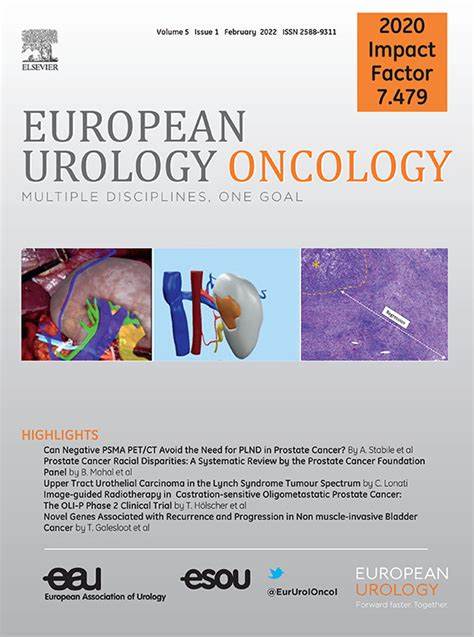Epidemiology of High-risk Biochemical Recurrence After Primary Prostate Cancer Treatment
IF 9.3
1区 医学
Q1 ONCOLOGY
引用次数: 0
Abstract
Background and objective
Biochemical recurrence (BCR) risk stratification guides treatment decisions after primary prostate cancer (PCa) treatment. We evaluated high-risk BCR (HR-BCR) definitions after radical prostatectomy (RP) or radiotherapy (RT) and their association with PCa-specific mortality (PCSM).
Methods
A population-based cohort study including 17 753 men treated with RP (n = 12 010) or RT (n = 5743) for localized PCa in Stockholm County between 2003 and 2021 was conducted. We assessed the cumulative incidence of any BCR (RP: prostate-specific antigen [PSA] ≥0.2; RT: PSA ≥nadir + 2), European Association of Urology (EAU) HR-BCR (PSA doubling time ≤1 yr or pathological International Society of Urological Pathology (ISUP) grade group 4–5 after RP; time to BCR ≤18 mo or biopsy ISUP grade group 4–5 after RT), and EMBARK HR-BCR (PSA doubling time ≤9 mo and PSA >1 ng/ml after RP or PSA ≥nadir + 2 ng/ml after RT). PCSM after HR-BCR was estimated using the competing risk method.
Key findings and limitations
The 10-yr incidence of HR-BCR was 10% (95% confidence interval [CI]: 9–11) for EAU HR-BCR and 4% (95% CI: 3–4) for EMBARK HR-BCR after RP, and 10% (95% CI: 9–11) for both definitions after RT. Patients meeting the EMBARK criteria had the highest PCSM (RP: 30%, 95% CI: 24–37; RT: 50%, 95% CI: 45–56). Up to 50% of RP and 31% of RT patients with BCR did not progress to HR-BCR and had lower PCSM.
Conclusions and clinical implications
HR-BCR incidence varies by definition and treatment. The EMBARK criteria identify a smaller subset with the highest PCSM risk. Many patients with BCR never develop HR-BCR. Refining BCR definitions with PSA kinetics and imaging may optimize risk stratification, balancing therapeutic efficacy and overtreatment.
原发性前列腺癌治疗后高危生化复发的流行病学研究。
背景与目的:生化复发(BCR)风险分层指导原发性前列腺癌(PCa)治疗后的治疗决策。我们评估了根治性前列腺切除术(RP)或放疗(RT)后高危BCR (HR-BCR)的定义及其与前列腺癌特异性死亡率(PCSM)的关系。方法:在2003年至2021年期间,在斯德哥尔摩县进行了一项基于人群的队列研究,包括17753名接受RP (n = 12010)或RT (n = 5743)治疗局限性PCa的男性。我们评估了任何BCR (RP:前列腺特异性抗原[PSA]≥0.2;RT: PSA≥最低点+ 2),欧洲泌尿外科协会(EAU) HR-BCR (PSA倍增时间≤1年或病理国际泌尿外科病理学会(ISUP)分级4-5组RP后;术后至BCR≤18个月或活检ISUP分级组4-5个月),hrbcr (RP后PSA翻倍时间≤9个月,PSA翻倍1 ng/ml或RT后PSA≥最低点+ 2 ng/ml)。采用竞争风险法估算HR-BCR后的PCSM。主要发现和局限性:EAU HR-BCR的10年发病率为10%(95%可信区间[CI]: 9-11), RP后EMBARK HR-BCR的10年发病率为4% (95% CI: 3-4), RP后两种定义的HR-BCR均为10% (95% CI: 9-11)。符合EMBARK标准的患者PCSM最高(RP: 30%, 95% CI: 24-37;Rt: 50%, 95% ci: 45-56)。高达50%的RP和31%的RT合并BCR患者没有进展为HR-BCR, PCSM较低。结论和临床意义:HR-BCR的发病率因定义和治疗而异。EMBARK标准确定了一个具有最高PCSM风险的小子集。许多BCR患者从未发展成HR-BCR。用PSA动力学和影像学来完善BCR定义可以优化风险分层,平衡治疗效果和过度治疗。
本文章由计算机程序翻译,如有差异,请以英文原文为准。
求助全文
约1分钟内获得全文
求助全文
来源期刊

European urology oncology
Multiple-
CiteScore
15.50
自引率
2.40%
发文量
128
审稿时长
20 days
期刊介绍:
Journal Name: European Urology Oncology
Affiliation: Official Journal of the European Association of Urology
Focus:
First official publication of the EAU fully devoted to the study of genitourinary malignancies
Aims to deliver high-quality research
Content:
Includes original articles, opinion piece editorials, and invited reviews
Covers clinical, basic, and translational research
Publication Frequency: Six times a year in electronic format
 求助内容:
求助内容: 应助结果提醒方式:
应助结果提醒方式:


